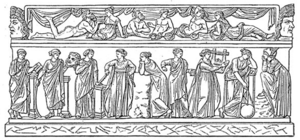Nine Lyric Poets

The Nine Lyric or Melic Poets were a canonical group of
Hellenistic Alexandria as worthy of critical study. In the Palatine Anthology it is said that they established lyric song.[1]
They were:
- Alcman of Sparta (choral lyric, 7th century BC)
- Sappho of Lesbos (monodic lyric, c. 600 BC)
- Alcaeus of Mytilene (monodic lyric, c. 600 BC)
- Anacreon of Teos (monodic lyric, 6th century BC)
- Metauros(choral lyric, 7th century BC)
- Rhegium(choral lyric, 6th century BC)
- Simonides of Ceos (choral lyric, 6th century BC)
- Ceos(choral lyric, 5th century BC)
- Thebes(choral lyric, 5th century BC)
In most Greek sources the word melikos (from melos, "song") is used to refer to these poets, but the variant lyrikos (from lyra, "lyre") became the regular form in both Latin (as lyricus) and in modern languages. The ancient scholars defined the genre on the basis of the musical accompaniment, not the content. Thus, some types of poetry which would be included under the label "lyric poetry" in modern criticism, are excluded—namely, the elegy and iambus which were performed with flutes.
The Nine Lyric Poets are traditionally divided among those who primarily composed
monodic verses. This division is contested by some modern scholars.[2]
Antipater of Thessalonica proposes an alternative canon of nine female poets.[3]
See also
References
- ISBN 1434491307[Retrieved 2015-05-06]
- ^ Cf. esp. M. Davies's "Monody, Choral Lyric, and the Tyranny of the Hand-Book" in Classical Quarterly, NS 38 (1988), pp. 52–64.
- ^ Fernandez Robbio, Matías S. (2014) «Musas y escritoras: el primer canon de la literatura femenina de la Grecia antigua (AP IX 26)». Praesentia, v. 15, 2014, pp. 1–9. ISSN (en línea): 1316–1857. (online)
